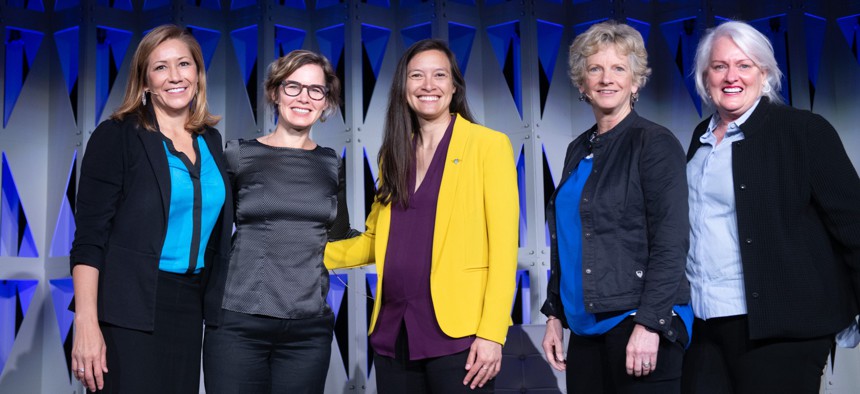
From left to right: Code for America CEO Amanda Renteria, CfA founder and former Deputy Federal CTO Jen Pahlka, U.S. Digital Service Administrator Mina Hsiang, General Services Administration head Robin Carnahan and Federal CIO Clare Martorana. Photo courtesy: Code For America
Federal CIO: The Tech is 'The Easy Part' of Improving Customer Service
Blockers to implementing service improvements frequently center around policy and process requirements, top tech officials said at the Code for America Summit on Tuesday.
The Biden White House priority to make government less of a hassle for Americans, and improve their satisfaction and trust in government in the process, will require changing internal, bureaucratic processes inside the government itself, said top tech officials during the Code for America Summit Tuesday.
"The technology is the easy part," federal CIO, Clare Martorana, told FCW in an interview. "I have not found a single thing in my now six-plus years in government that was actually a confounding technical problem."
Agencies are currently implementing a list of specific projects to remake government services, as directed by a 2021 executive order from President Biden and priorities in the President's Management Agenda.
The goal isn't simply to accomplish these projects, Mina Hsiang, administrator of the U.S. Digital Service, told FCW on the sidelines of the conference. "It's about making iterative, user-centered design the status quo for how we implement programs."
Some progress has already been made, said leaders Tuesday. Critically, these efforts to make government easier for citizens to access have White House backing.
"We've been talking about it for a long time, that you can't do tech without that feedback loop," said administrator of the General Services Administration, Robin Carnahan, during a Tuesday panel. "To have the president talk about that and sign an executive order and put the word out across all the agencies and all the government, 'this has gotta be a top priority' – that's a win, yall."
At the Office of Management and Budget itself, the executive order has been a "unique organizing principle," said Martorana.
"The director of OMB has cascaded this throughout the entire organization to make this a top focus," she said. "The president really cares about this… so I am seeing something reflected back to us, which makes our work easier."
Hsiang and Carnahan both alluded to a broader understanding across government that including tech teams in the policymaking and implementation process helps policies roll out successfully.
Still, Hsiang told FCW that she often sees teams having to confront the way that the creation of policy ideas and then legislation often happen separately from implementation, and from the actual use of whatever service being made.
That fragmentation can create policy blockers that prevent service improvements, requiring collaboration with decision-makers to get the non-tech changes needed for service delivery improvements, she said.
"Policy implementation is sort of this very linear process," she said, pointing to the Center for Medicare and Medicaid Services' implementation of the Medicare Access and CHIP Reauthorization Act as an example of trying to use human-centered design instead of more traditional implementation processes. Hsiang formerly worked on a USDS team with the Department of Health.
One goal was to give doctors more performance data.
"We don't know what the most usable format will be. We don't know what the data will look like," she said of the project.
"So we could do what we normally do, which is pre-specify it and hope that it's useful… Instead what we did is we laid out a process and we said, 'OK. So we're going to get the data, and then we're going to run this iterative, human-centered process to develop data reports that are actually useful to people,'" she said.
Implementing changes in federal programs run by states also often surfaces questions about what federal oversight or requirements come with that program, said Hsiang.
States wanting to use a new solution to determine who's eligible for Medicaid might have to work with CMS to see if a solution meets requirements or if a waiver was needed, she said.
The executive order on customer experience has "operational structures" meant to ease the process of collaboration between agencies and OMB to make that type of back-and-forth faster – "the shorter you can make the process, the more iterations you can do," said Hsiang.
One public-facing priority from the Biden administration is an effort to reorganize government service delivery around life experiences, rather than bureaucracy.
Here too, is iterative design. How exactly this looks at its conclusion might change as efforts progress, Martorana told FCW.
In the panel, Martorana said that a long-term sign of success for current efforts in government would be having "a single front door to government that you can come in, and that we know who you are, and it's safe and secure for you to transact with the government and you're treated with respect and kindness."
There is a line of effort ongoing to rebuild GSA's USA.gov website to enable it to be that single website where Americans can complete a litany of services in one place.
Organizing around life experiences "gets us on the path to start thinking about how a customer transits multiple agencies and how we design the best experience for that person and then what possible policy changes have to happen," Martorana told FCW. "That's how I really think about it, is taking the baby steps forward."
"We're going to learn incrementally, because we're not building the whole thing out and then trying to figure out if all of our customers want to use this thing, right?" she continued. "We'll learn that through this iterative process of designing."







